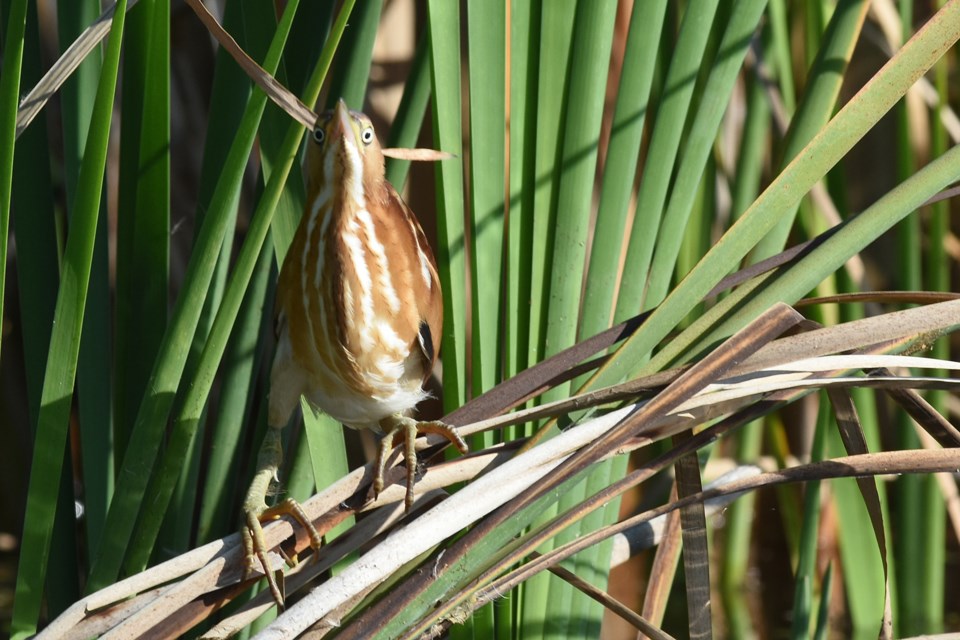My paddle was literally mid-swing when our eyes locked. “Least bittern! Least bittern! Least bittern!” I screamed silently to myself. This was a very special interaction indeed.
The least bittern is a smallish heron that frequents huge cattail marshes. As huge cattail marshes are found only infrequently these days, this species has lost its population count dramatically and is now listed as a species at risk in Ontario. There are precious few wetlands remaining that are large enough for this pretty heron to call home.
That said, I have been fortunate enough to encounter them at Tiny Marsh, Wye Marsh, the Ken Reid Conservation Area and today within the swaying masses of cattails at the Matchedash Bay Provincial Wildlife Area. Sightings are usually only a single bird and but a glimpse of it flying away; thankfully, they have a bright tan patch of feathers on the wings, so are easy to identify.
Like most herons, these small bitterns hunt for dragonflies and frogs along the open edges of a cattail jungle. The larger American bittern shares this micro-ecozone along with its larger cousin, the great blue heron. The great blues are shy, the American bitterns shyer, and the least bitterns are a feathered bundle of avian anxiety, so getting close to one is very, very difficult.
Yet here I was, drifting along the North River, being somewhat bemused by the piles of painted turtles scattered along the shoreline, when I focused on a tan patch in the cattails. “Least bittern!”
Now, both American and least bitterns are masters of camouflage, so much so that to see one in advance of it seeing you is nigh on impossible. They can have you spotted, scanned, analyzed and have two escape routes planned before you can even complete a paddle swing. The time between the two of you locking eyes on each other and their flight plan being initiated is about one millisecond.
Of course, the time required for me to stow the paddle, lift the camera, find the bird in the viewfinder, focus the darn thing, and remember to turn the “on” switch on takes a good handful of milliseconds. Lots of time for the skittish bird to catch some air and put a bit of distance between you and it.
However, this time I was lucky, as this particular least bittern was more interested in picking the cattails clean of emerging dragonflies than of a big drifting log under a Tilley hat. The shutter clicked rapidly, at least best I could do so with heart pounding. Did manage to get a couple of shots in focus and in the frame.
Within Matchedash Bay is the confluence of two major rivers, the North and the Coldwater. A natural ‘pocket’ of granite rock creates the gateway from Georgian Bay to this inland bay and wetland. Lots of history here, from the establishment of the area’s first trading post (Cowan’s) to the manufacture of sailing ships to being a British hidey-hole from American warships.
I can only imagine the thoughts of some poor private as he rowed a scow full of goods up or down the rivers. Nothing to see but cattails towering high overhead and every bend in the river looking exactly the same as the last.
Today it is protected land and is labelled as being a Ramsar site, which is a habitat of global significance; the somewhat nearby Minesing swamp also has this title bestowed upon it. Pretty cool, and right here in our collective backyard.
The rest of my photo journey should have been anticlimactic after the encounter with the least bittern, but a myriad of other wetland critters kept the camera shutter clicking: a Caspian tern cruising by overhead, a belted kingfisher hovering and diving on minnows in the middle of the river, migrating barn swallows swooping by in search of insect fuel for their trip to Argentina.
A closer look at the lily pads revealed a world of activity, not just as resting areas for bullfrogs but as hunting grounds for yellow-jacket hornets. Each leaf had one or two of the yellow-and-black-banded hunters scouring the surface for itty-bitty, teeny-weeny, juicy something-or-another bugs. Probably not truly ‘bugs’ but you know what I mean. Juicy morsels.
From looking small to looking big, the skyscapes over this wide open area are spectacular. I don’t know what I’m going to do with them all, but I have dozens and dozens of pics of cumulus, cirrus and nimbus clouds.
Now that we are into September, the fall migrations will be picking up with many waterfowl, shorebirds, songbirds and falcons flowing through this area. We are very fortunate to have this area available to us, so whether it be on the trails or on the water, I hope you have an opportunity to get out and be part of nature’s seasonal shift.
